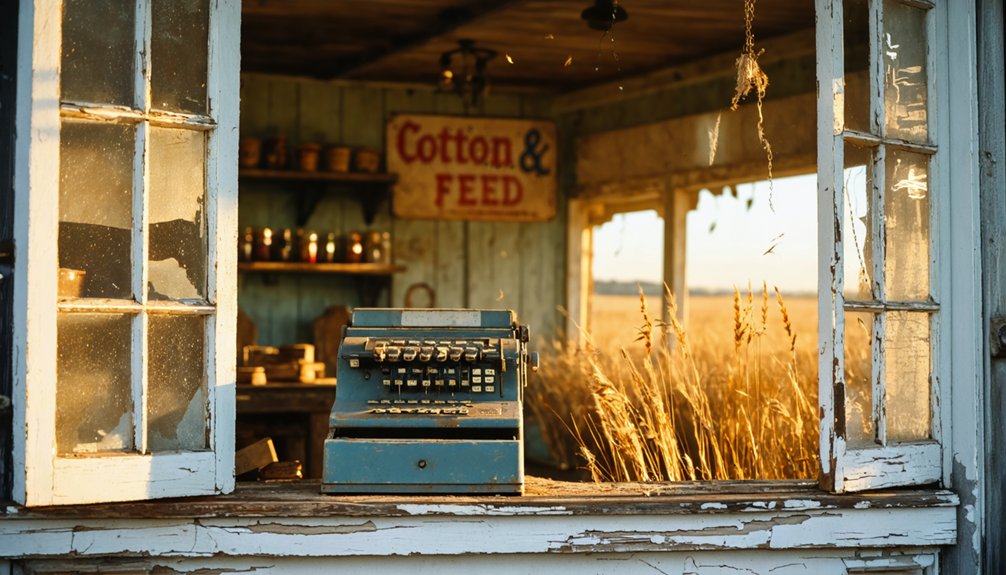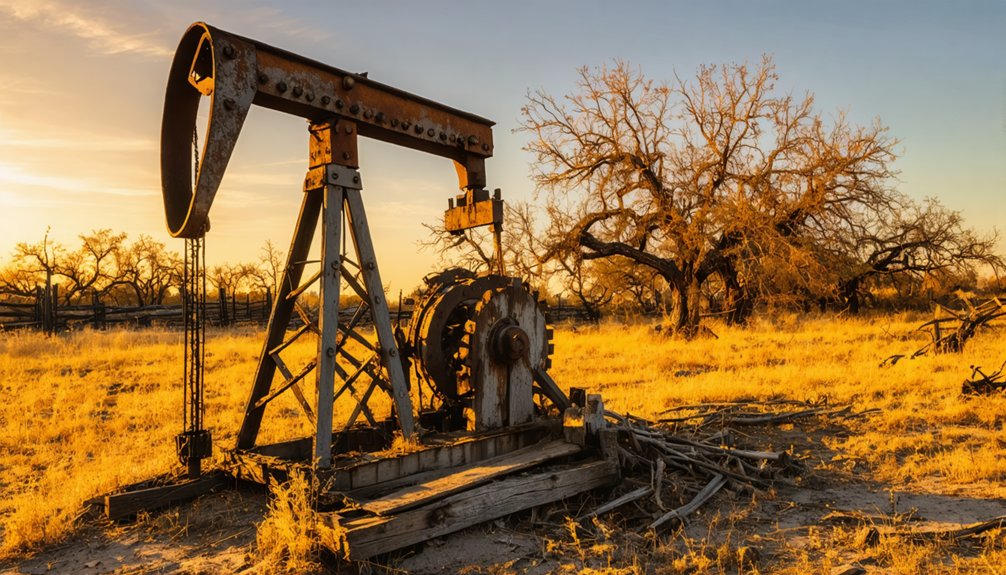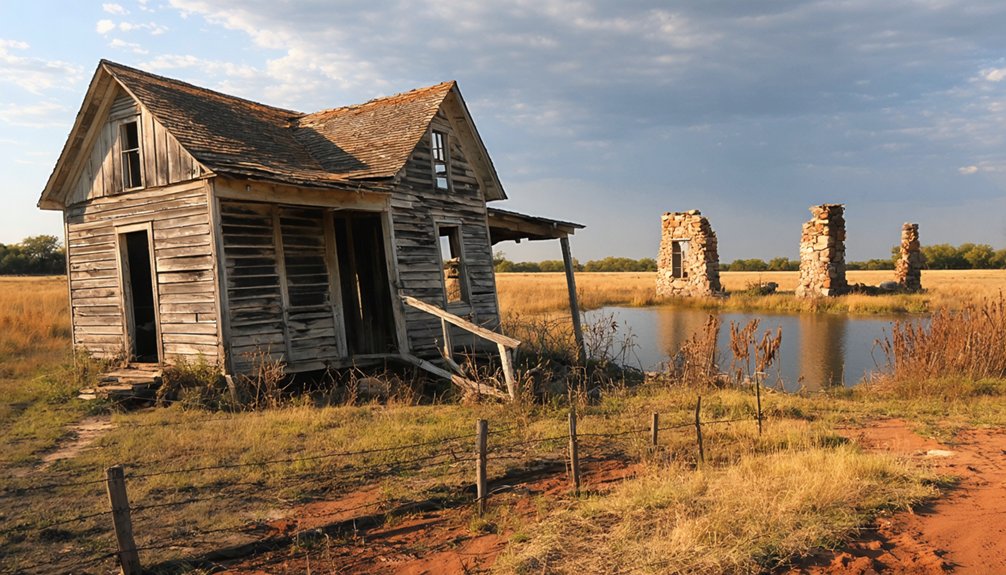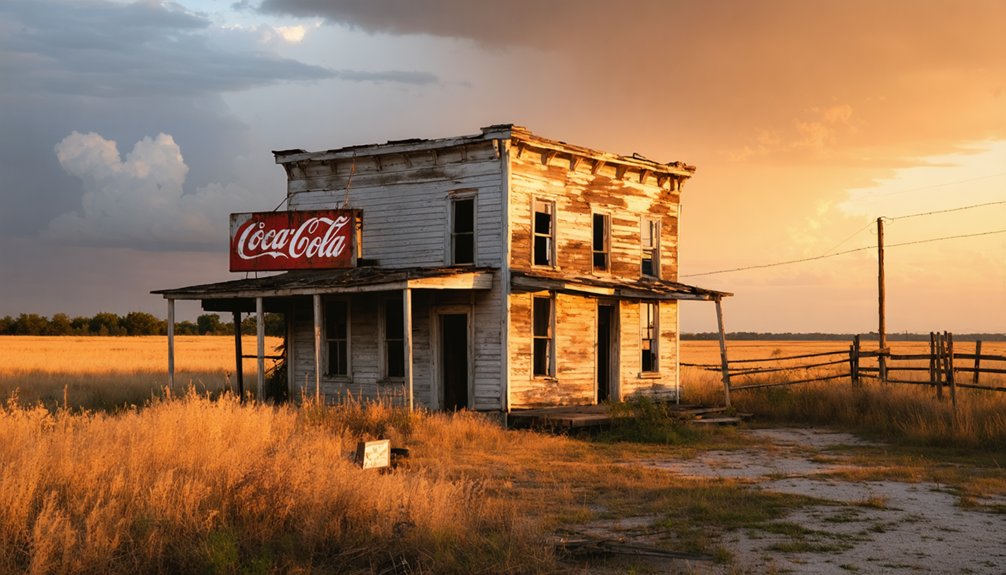You’ll find Grass Pond Colony at 29°15′05″N and 98°07′46″W in northern Wilson County, Texas, where natural springs once sustained a thriving agricultural settlement. The colony emerged in the 1840s, offering settlers fertile soil, timber, and reliable water sources at 581 feet elevation. While the community prospered through cotton and watermelon farming, economic pressures and demographic shifts led to its abandonment, joining Wilson County’s network of 31 ghost towns. The site’s spring-fed ponds still mark this forgotten piece of Texas history.
Key Takeaways
- Grass Pond Colony was established in the 1840s near natural springs in Wilson County, Texas at coordinates 29°15′05″N and 98°07′46″W.
- The settlement thrived on agriculture, particularly cotton and watermelon farming, supported by spring-fed ponds and rich blackland prairie soil.
- Natural springs maintained consistent water levels, providing year-round water sources for farming, livestock, and community development.
- Economic pressures, demographic shifts, and limited access to transportation routes led to the colony’s eventual abandonment.
- Grass Pond Colony is one of Wilson County’s 31 ghost towns, with its site now on private property with restricted access.
Natural Springs and Water Features
Several natural springs fed the ponds that gave Grass Pond Colony its name, creating an important year-round water source in northern Wilson County, Texas.
You’ll find these artesian springs emerge from underground reservoirs through natural geological formations, maintaining consistent water levels even during dry seasons.
The spring ecology of these ponds created ideal conditions for settlement and farming, while supporting diverse wildlife including fish, amphibians, and birds.
Natural springs nourished vibrant ecosystems where settlers thrived alongside diverse wildlife, creating a perfect balance between human needs and nature’s abundance.
The springs’ natural water conservation properties guaranteed stable aquatic habitats and reliable drinking sources for both humans and livestock.
These permanent water features proved vital for the colony’s survival, as the springs’ clean, pressure-fed water sustained daily domestic needs and agricultural activities.
Located five miles south of Sutherland Springs, the colony benefited from its strategic position near multiple water sources.
The geological blocking mechanisms typical of Texas springs kept these water sources flowing consistently, making them invaluable to the community.
The ponds’ location just 2 miles northwest of Red Bluff provided additional geological protection for the water system.
Early Settlement Origins
While many Texas settlements emerged through organized colonization efforts, Grass Pond Colony‘s origins trace back to the ambitious land-seeking pioneers of the 1840s who were drawn by free land offers near the Trinity River forks.
You’ll find that settler motivations centered on securing prime locations near creeks and springs, where they could access water, timber, and the coveted Trinity soil series – rich dark clay perfect for farming. Similar to the process in Austin’s Second Colony, settlers received official land grants to establish their homesteads. Like the German settlers who arrived in Bridge Valley in the 1880s, these pioneers helped establish vital community infrastructure.
These early settlers often established their land claims without detailed knowledge of the territory, relying on chain surveys and reports from previous explorers. They’d typically settle in family clusters, creating tight-knit communities around essential amenities.
Like many Texas settlements of the era, overlapping land claims sometimes sparked conflicts, especially as rapid expansion brought more pioneers to the area.
Life in the Colony’s Heyday
During Grass Pond Colony’s peak years, you’d find settlers capitalizing on the rich blackland prairie soil to cultivate cotton, which became their primary trade commodity.
You could spot the community’s social life flourishing around the natural springs and ponds, where families gathered to share resources and labor while maintaining cultural ties. Like many Texas communities in the 1880s, the introduction of barbed-wire fencing transformed how residents managed their livestock and farmland.
If you’d visited the local churches and schools during this period, you’d have witnessed the segregated but vibrant social gatherings that sustained the colony’s cultural identity.
Agricultural Activities and Trade
As natural springs provided year-round water sources, Grass Pond Colony developed into a thriving agricultural community built on diverse farming practices and active trade networks.
You’d find extensive crop diversity through staples like corn, beans, squash, and cotton, while livestock management included cattle, goats, and horses integrated with field rotation techniques. The colony’s abundance of reliable water sources helped sustain both crops and livestock throughout all seasons. By 1915, some farmers diversified into watermelon cultivation, which became a profitable cash crop in the region.
The colony’s economic strength came from:
- Small-scale farming that produced both subsistence crops and trade surplus
- Livestock operations yielding meat, hides, and dairy products
- Active trade routes connecting to markets in Sutherland Springs and beyond
You’d see farmers using period-typical tools like plows and sickles, working alongside basic irrigation systems fed by springs.
This agricultural foundation supported wealth accumulation and sustained the colony’s growth through its ability to produce tradeable surpluses.
Social Life Around Springs
Because natural springs dotted the landscape of Grass Pond Colony, these water sources became the heart of community life and social gatherings. You’d find families congregating around spring-fed ponds for fishing, swimming, and sharing stories.
These spots served as natural meeting places where community traditions flourished through seasonal festivals and celebrations. Much like Granville Sherwood’s early settlement, the area drew residents together through shared resources. Social traditions centered on the springs, where religious services, cultural ceremonies, and informal trade took place.
You’d hear music playing during festivities while children enjoyed games in nearby open spaces. The springs fostered tight-knit social networks among multi-generational families, strengthening kinship ties and community bonds.
Word-of-mouth communication spread quickly at these gathering spots, where residents exchanged news, conducted business, and maintained the colony’s vibrant social fabric through shared experiences around these life-giving waters. Like many of the 511 ghost towns in Texas, these cherished gathering places eventually fell silent as the community declined.
Geographic Significance
Three key geographic features defined Grass Pond Colony‘s significance in northern Wilson County, Texas.
You’ll find the settlement marked on historical maps at coordinates 29°15′05″N and 98°07′46″W, where geographic mapping reveals its strategic position within a network of rural communities. Located in the Central Time Zone, the area remains aligned with major regional population centers.
- Natural springs and ponds provided year-round water access, essential for sustaining life in the semi-arid region.
- Elevation of 581 feet offered tactical advantages and clear sightlines to surrounding areas.
- Central location connected the colony to multiple towns including Sutherland Springs, La Vernia, and Floresville.
The settlement’s historical significance stems from its position at the crossroads of regional development, with proximity to modern military installations and critical infrastructure demonstrating its enduring geographic importance in South Central Texas.
Economic Activities and Trade

While the Peters Colony land grant program served as the economic foundation of Grass Pond Colony, the settlement’s diverse commercial activities extended well beyond basic farming.
You’ll find the settlement dynamics were shaped by mixed agriculture, with settlers cultivating 15-acre minimum plots and raising livestock on the fertile black soil. The abundance of natural water sources supported year-round farming operations and animal husbandry.
Mixed farming shaped life in Grass Pond Colony, with 15-acre plots sustaining crops and livestock on rich soil near water sources.
Local trade routes, often following established trails like the Camino Real, connected the colony to broader markets. You could’ve found settlers trading surplus crops, livestock, and locally mined limestone and gravel.
The community’s economic base was further strengthened by small-scale resource extraction, including timber harvesting and mineral collection, while seasonal wildlife migrations provided additional trading opportunities through hunting and fishing.
The Path to Abandonment
As environmental pressures mounted in the late 19th century, Grass Pond Colony faced a complex web of challenges that ultimately led to its downfall. The settlement’s proximity to natural springs, while initially beneficial, created flooding risks that threatened the community’s stability.
Economic pressures and demographic shifts accelerated the colony’s decline, as younger residents sought opportunities in nearby urban centers.
Key factors in the colony’s abandonment included:
- Deteriorating infrastructure without investment in modernization
- Limited access to major transportation routes and trade networks
- Aging population combined with outmigration of working-age residents
You’ll find that the lack of essential services and isolation from regional development pushed the remaining inhabitants to depart, leaving buildings to decay and the once-vibrant community to fade into history.
Legacy in Wilson County

Despite its eventual abandonment, Grass Pond Colony left an enduring imprint on Wilson County’s historical landscape.
You’ll find its legacy preserved in genealogical records, historical maps, and local archives that document the community’s contribution to the county’s cultural heritage. The colony’s strategic location near natural springs, which remain active today, offers valuable insights into early settlement patterns and resource management in South Texas.
The site continues to serve as a testament to Wilson County’s community identity, particularly through its inclusion in historical research projects and centennial programs.
You can trace the colony’s influence through various historical texts, including “African Americans in Wilson County Texas,” which highlights its role in the region’s ethnic and demographic development. The preserved spring-fed ponds stand as lasting landmarks of this once-thriving rural settlement.
Preservation Status Today
Today you’ll find Grass Pond Colony‘s natural features largely undisturbed, with its original pond and surrounding grasslands remaining relatively unchanged despite the site’s abandonment.
Archaeological surveys of the area have been minimal, leaving much of the settlement’s physical history unexplored and undocumented.
While the site sits on private property with restricted access, no formal preservation measures protect the remaining historical elements from further deterioration.
Natural Features Remain Intact
While human settlements have long since vanished from Grass Pond Colony, the site’s natural features remain remarkably preserved.
You’ll find year-round water-filled ponds spanning up to 50 acres, reaching depths of 10 feet and sustaining a thriving natural habitat of lily pads and waterfowl. A bubbling spring feeds the ecosystem balance, supporting trees and riparian vegetation amid the Chihuahuan Desert landscape.
The site maintains its original character with:
- Natural ponds that resist drainage attempts due to stable water flow
- Dense desert vegetation including catclaw, mesquite, and native grasses
- Abundant wildlife supported by the preserved wetland environment
Despite minimal structural remains, the untamed landscape tells the story of this ghost town through its enduring natural elements.
Limited Archaeological Investigation Status
Archaeological investigations of Grass Pond Colony remain especially limited, with only surface-level surveys and minimal test excavations documented in regional records.
You’ll find no extensive studies specifically focused on the colony itself, leaving significant gaps in our understanding of this historic site.
The archaeological methodology has consisted mainly of basic surface surveys and shovel tests, without any systematic large-scale excavations.
Preservation challenges plague the site, including natural erosion, vegetation overgrowth, and potential disturbances from agricultural activities.
You won’t find the colony listed on the National Register of Historic Places or designated as a State Antiquities Landmark, reflecting its limited formal protection status.
Reports from Texas Parks and Wildlife Department primarily focus on cataloging and monitoring, often noting site disturbance and ineligibility for landmark status due to insufficient findings.
Site Access and Protection
Despite its historical significance, Grass Pond Colony remains largely inaccessible to the public, with no formal tourist facilities or interpretive infrastructure in place.
You’ll encounter significant access challenges since the site sits on private or unposted land, requiring landowner permission for visits. Without formal protection status or preservation efforts, the site’s historical remnants face ongoing natural degradation.
Key site conditions you should know:
- No developed trails or directional signage exist to guide exploration
- Natural springs maintain the historic ponds, but built structures have largely disappeared
- The site lacks official historic designation or preservation funding
The colony’s future preservation depends primarily on private landowner stewardship and county-level oversight, rather than state or federal protection programs.
Local historical societies acknowledge its importance, but broader heritage management remains minimal.
Notable Historical Events
Throughout Grass Pond Colony‘s brief existence, few major historical events shaped its trajectory beyond the typical patterns of rural Texas settlements.
You’ll find its story marked by the common settlement challenges faced by farming communities in Wilson County during the late 19th and early 20th centuries.
The colony’s most significant events centered around its economic struggles, including periods of drought and crop failures that tested the resilience of its farming families.
You can trace the community’s gradual decline through various agricultural downturns, which ultimately led to its abandonment.
The bypassing of major transportation routes dealt another blow to the settlement’s prospects, isolating it from crucial trade opportunities.
These combined factors eventually transformed this once-hopeful farming colony into one of Wilson County’s 31 ghost towns.
Regional Ghost Town Context

You’ll find Grass Pond Colony situated within Wilson County’s extensive network of over 30 ghost towns, making it part of Texas’s largest concentration of abandoned communities.
The settlement patterns here mirror those of neighboring ghost towns like Lodi and Floresville, which also emerged during regional economic booms and declined due to shifting infrastructure.
Wilson County’s ghost towns form an interconnected historical landscape that tells the broader story of Texas settlement and abandonment cycles.
Neighboring Abandoned Communities
While Texas harbors numerous ghost towns across its vast landscape, Wilson County stands out with the highest concentration, containing 31 abandoned settlements including Grass Pond Colony’s neighbors Graytown, Guilford, Kicaster, Kosciusko, and Las Cabras.
When you’re planning your ghost town exploration through these neighboring communities, you’ll discover a fascinating pattern of abandonment that tells the story of economic shifts and changing transportation routes.
These towns offer varying degrees of remnants:
- Graytown exists as a spread-out rural community with scattered ruins
- Most sites feature historic cemeteries and building foundations
- Some locations have been completely reclaimed by nature
The proximity of these ghost towns to each other reveals how regional factors like railroad changes and agricultural mechanization affected entire areas, not just isolated communities.
Settlement Pattern Similarities
Despite their unique individual histories, ghost towns across Wilson County share striking settlement patterns that reflect broader regional trends in Texas town development and decline.
You’ll find these abandoned communities were typically established near essential water sources and along major transportation routes, particularly railroad lines that later lost prominence to highways. Most settlements clustered around trading posts or mission sites for mutual support, following the natural terrain features that offered defense and climate advantages.
Like Grass Pond Colony, neighboring ghost towns often developed around single industries or agricultural ventures, making them vulnerable when economic conditions shifted.
You’ll notice how these communities initially boomed with resource exploitation but gradually declined as younger residents left, services disappeared, and infrastructure deteriorated.
Wilson County Ghost Network
The remarkable concentration of ghost towns in Wilson County sets it apart as Texas’s most densely abandoned region, with 31 documented ghost settlements scattered across its landscape.
You’ll find these ghost town dynamics deeply rooted in the county’s historical significance, where economic shifts and changing transportation routes led to widespread community abandonment.
- The Wilson County Historical Society actively preserves these forgotten places, documenting their stories and stabilizing remaining structures.
- Transportation changes, especially the decline of railroads, created a network of interconnected abandonments that shaped the region.
- Local cultural tourism now capitalizes on this unique heritage through ghost tours and paranormal investigations at historic sites.
This ghost town network offers you a fascinating glimpse into Wilson County’s past while contributing to its modern identity through heritage tourism.
Frequently Asked Questions
Were There Any Famous Outlaws or Lawmen Associated With Grass Pond Colony?
You won’t find any documented outlaw legends or lawman tales tied to this location. Historical records don’t show any famous law enforcement figures or notorious criminals operating in this settlement.
What Indigenous Tribes Inhabited the Area Before Grass Pond Colony’s Establishment?
From hills to homelands, you’d find Tonkawa, Karankawa, and Akokisa Native American tribes in this region, with Comanche and Apache influences shaping the area’s rich cultural heritage before settlement.
Did Any Significant Epidemics or Natural Disasters Affect the Colony?
You’ll find that malaria hit the colony hard, spreading from the stagnant pond waters. Yellow fever epidemics also struck nearby regions between 1839-1867, though direct impacts aren’t confirmed for Grass Pond.
What Was the Ethnic Composition of the Original Grass Pond Settlers?
You’ll find the original settlers were primarily Anglo-Americans, sharing settler backgrounds with Austin’s colony. Like most early Texas settlements, they brought their Southern cultural influences and established cotton-farming communities.
Were There Any Schools or Churches Established During the Colony’s Existence?
You won’t find records of established schools or churches in historical documents. Local school history suggests residents likely attended institutions in nearby towns, while church influence came from surrounding communities.
References
- https://texashighways.com/travel-news/four-texas-ghost-towns/
- https://www.southernthing.com/ruins-in-texas-2640914879.html
- https://www.ksat.com/holidays/2018/10/30/texas-has-more-ghost-towns-than-any-other-state/
- http://texasghosttowns.blogspot.com/2011/
- https://en.wikipedia.org/wiki/List_of_ghost_towns_in_Texas
- https://en.wikipedia.org/wiki/Grass_Pond_Colony
- https://www.wilsoncountyhistory.org/talk-wilson-county
- https://kids.kiddle.co/Grass_Pond_Colony
- https://mapcarta.com/21734874
- https://www.twdb.texas.gov/publications/reports/numbered_reports/doc/R189/R189.pdf



